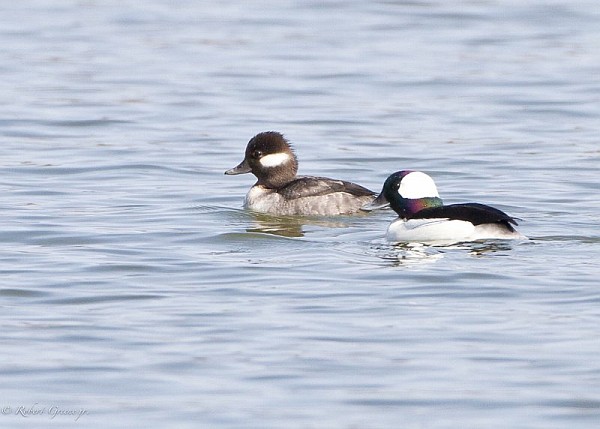
Today I’ll finish the list of ducks you’re likely to see in western Pennsylvania with tips on how to identify them from a distance.
I’ve limited this series to ducks seen in the western part of the state, but our area is large and diverse so some birds are common in Erie and Crawford counties during migration, but not in Pittsburgh.
All the birds in this final set are divers. Some are small, some are unusual, some are so similar they’re hard to tell apart.
As before I’ll use abbreviations to save space and use mallards as our reference duck: “=M” is same size as mallard, “<M” smaller than mallard, “>M” bigger than mallard. “HFAM” means Hope For A Male because the females are really hard to identify.
So here goes:
- Scoters: These sea ducks spend the winter at the coast but are seen in flocks during migration at Lake Erie. Lumpy bill. Males almost completely black. Females brown. These species look alike from afar. Definitely difficult divers.
- Surf scoter: =M. Least common of the 3 in western PA. Male all black, white eye ring, white on forehead and back of head, colorful black-white-orange bill. HFAM.
- Black scoter: slightly <M. Male all black. Orange-yellow lump on top of bill. Female brown with paler face, neck. HFAM.
- White-winged scoter: =M. Male all black with white eye shadow below his eye and orange tip on black bill. White wing may be hard to see when swimming. HFAM.
- Long-tailed duck: < M. Small round head, stubby bill, brown cheek. Male has unmistakably long tail but often drags it on the water when swimming. Male mostly white in winter, brown cheek and chest. Female duller with brownish back. Wears 3 plumages per year so check your field guide. Unusual in southwestern PA.
- Common Goldeneye: < M. Bulbous, almost triangular, dark head. Golden eye. In spring, male mostly white, some black on back, head blackish-green with white face spot. Female and eclipse male: brownish back and white belly topped by chocolate brown, bulbous head.
- Bufflehead: <<M. Very small duck with large round head. Male mostly white, black on back, big white quarter-of-a-pie on top-back of head. Female is a same shape in brown with white cheek splash on brown head.
- Ruddy duck: <<M. Very small brownish duck with short neck, large head, large broad bill, white cheek patch. In spring, male is ruddy-colored with black head, bright white cheek, blue bill (!) and cocked tail while swimming. Learn this duck’s profile and you’ll know him no matter what plumage he’s in.
- NOT a duck but a small diver — Pied-billed Grebe: << M. Very small brown bird same size as bufflehead but with longer neck, stubby bill. When diving, appears to jump up and arc into the water rather than slip into it.
Armed with these hints, can you identify the birds above? …I didn’t label them this time… 😉
(photo by Bobby Greene)
Kate,
There is a large bird, I think a peregrine or red tail, being a novice @ species recognition I’ m not sure, that has been perched on my building for two days now without moving. I tapped on the gutter and it looked @ me but did not move beyond that. I am growing concerned that there may be something wrong. I have snapped a couple of photos but I am not sure how to upload them so you can review them. Also, is there someone I can contact for assistance?
Thanks,
Mike
It’s good news that it looked at you. From the picture you sent, I can tell it’s a red-tailed hawk (sleeping, in your photo). If it leaves during the middle of the day, then it’s OK… it just happens to like your house as a roost.
Don’t be concerned if it perches for a while. Raptors are slow to get moving in the morning.
male and female bufflehead?
Correct!
Hi Kate, Thanks for the duck identification posts. I was just down at the Allegheny River on the northshore and saw what i think is a Western Grebe! Is that possible? I did a little online search and have found at least one sighting of these in PA. It was a bit larger than a pied-billed grebe, had a black cap and black back of neck and the rest of its face and neck was white and the back and body was grey. It was swimming and diving. I didn’t get a close enough look for the eye color and bill. The bill wasn’t bright yellow so i think it was a Western rather than a Clark’s grebe. By the way I love your blog! Keep up the good work!
Jim, check your field guide for the winter plumage of the horned grebe. I’ve heard that they’ve been moving through western PA. We never see many of them. It’s always a treat to find one.
Western & Clark’s grebes (especially Clark’s) are very, very rare in Pennsylvania so it’s most likely you saw a horned grebe.
Thanks! That is exactly what I saw.
Meaning I saw a horned grebe. Thanks again, and again- awesome blog!